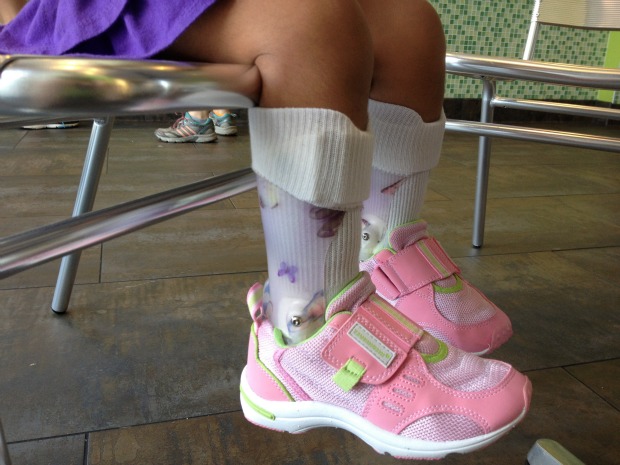Ambulatory kids with mild cerebral palsy have adverse musculoskeletal profile
Compared with typically developing children, ambulatory children with mild spastic cerebral palsy (CP) have pronounced deficits in cortical bone architecture, lower bone strength, and elevated infiltration of fat in the bone marrow and muscle of the lower legs, new findings show.

By Joan Stephenson, Medscape October 28, 2016
NEW YORK (Reuters Health) — “The findings are concerning because poor bone architecture and an elevated bone marrow adiposity are associated with an increased risk of fracture,” researchers write in Bone, online October 9. “Moreover, elevated bone marrow and muscle adiposity are linked to impaired glucose tolerance and cardio-metabolic disease.”
Although previous work demonstrated that non-ambulatory children with severe CP have an adverse musculoskeletal profile, it had been unclear if that is also the case for ambulatory children with a milder form of CP.
To investigate, a team led by researchers at the University of Delaware, Newark, used magnetic resonance imaging to examine 12 ambulatory children with mild CP and 12 typically developing children, focusing on bone architecture and bone marrow fat in the midtibia, as well as muscle and fat tissue volume and intramuscular fat concentration in the midleg.
There were no differences between the groups in age (mean 8.8 years, ranging from 4 to 11), height, body mass, and many other characteristics, although children with CP were significantly lower in height percentile (19th versus 50th percentile) and were less physically active (as determined by physical activity ankle monitors) than children in the control group.
Imaging revealed significant bone architecture deficits in the children with CP compared with controls. They had 30% less cortical volume (12.3 cm3 for CP children vs. 17.6 cm3 for controls), 32% less cortical width in the medial portion of the shaft (0.26 cm3 vs. 0.38 cm3, respectively), and 15% less total bone width in the medial lateral direction (1.04 cm vs. 1.22 cm, respectively).
Children with mild CP also had lower estimated bone strength compared with controls, as well as 39% less midleg muscle volume (144.8 cm3 vs. 237.1 cm3).
These findings, along with findings from previous studies, suggest that these “considerable bone strength deficits …need clinical attention,” the authors say.
In addition, the CP group had a significantly higher concentration of fat within the bone marrow cavity of the midtibia (82.1% vs. 80.5% for controls), and greater infiltration of fat in the surrounding leg muscle (25.0% vs. 16.1%).
The magnitude of the deficit in bone architecture and strength “is surprising,” the researchers said. However, the deficit is smaller than found in nonambulatory children with CP in a previous study, which is not surprising because the more physically active children with mild CP experience mechanical loading (which promotes cortical expansion and bone strength) when they walk or run.
Additional studies are needed, the authors say, to determine whether a disruption in glucose homeostasis or insulin function plays a role in the adverse effects on the musculoskeletal system found in children with mild CP, and whether increased physical activity or other interventions would improve bone architecture and reduce fat infiltration.
A few studies suggest that treatment such as high-frequency, low-magnitude vibration may help address such bone deficits, the researchers note.
Factors such as muscle weakness, obesity, and poor bone health may increase the risk and severity of secondary conditions throughout life in patients with CP, Dr. Mark Peterson of the University of Michigan, Ann Arbor, told Reuters Health by email.
Dr. Peterson, who was not involved with the study, and colleagues recently demonstrated that adults with CP have increased intermuscular and visceral fat and higher odds of developing diabetes, stroke, asthma, hypertension, and heart conditions, including heart attack and angina.
In addition to demonstrating that even ambulatory children with CP have smaller muscles, low bone density and strength, and greater intramuscular fat than typically developing children, the new work indicates for the first time “that children with CP have greater infiltration of fat in the bone marrow depot, thereby potentially placing them at higher risk of fracture,” he noted.
Thus, there’s a critical need to devise clinical strategies for early screening efforts among children with CP, he said, and for approaches “such as tailored physical activity and healthy nutrition interventions to bolster preservation of function and musculoskeletal integrity in this population.”
| The authors did not respond to requests for comment by press time. The study had no commercial funding. |
 Source Medscape
Source Medscape
| References |
Cortical bone deficit and fat infiltration of bone marrow and skeletal muscle in ambulatory children with mild spastic cerebral palsy, Whitney DG, Singh H, Miller F, Barbe MF, Slade JM, Pohlig RT, Modlesky CM. Bone. 2016 Oct 11;94:90-97. doi: 10.1016/j.bone.2016.10.005. [Epub ahead of print]
Also see
What you might not know about cerebral palsy The Art of Simple
